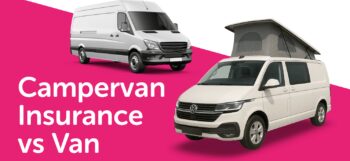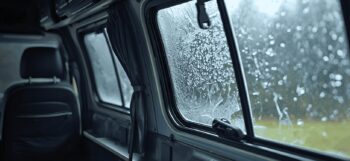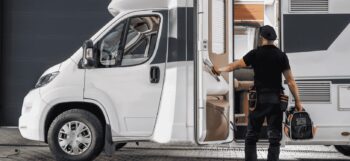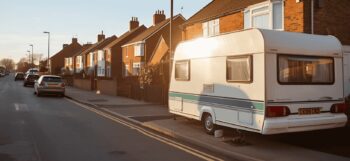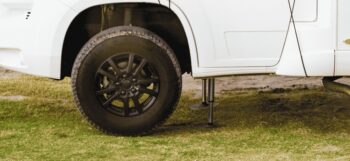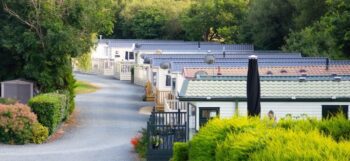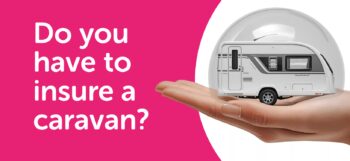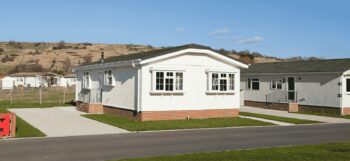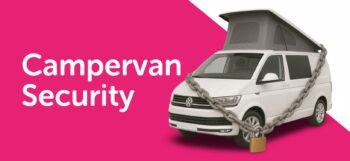Buying a touring caravan unlocks a world of possibilities, from relaxing weekends in the countryside to extended adventures across the UK and beyond. However, buying a caravan isn’t just about picking the one that looks good. You need to consider practical aspects like size, weight, berths, budget, and even where and when to buy.
This guide provides the things we feel you need to know to make an informed purchase, including layouts, towing compatibility, storage, and essential security.
Understand Your Needs
Before buying a caravan, spend time identifying exactly what you will need from it. A family of four will have vastly different requirements compared to a couple planning retirement road trips.
Key Factors to Consider
- Size: Think about where your caravan will be stored when not in use. Can it fit on your driveway, or will you need a dedicated storage facility? Additionally, ensure the caravan fits within your car’s towing capacity - more on this later.
- Berths: Caravans range from compact two-berth models for couples to spacious six-berth options for larger families. Choose a model that comfortably accommodates your travel group size, without compromising on storage space.
- Travel Style: Will you be using the caravan for weekend breaks, full-time living, or summer holidays? This will influence your choice of layout and features. For example, if you’re planning winter trips, look for a caravan with good insulation and a heating system.
Features and layouts
When considering buying a touring caravan, knowing what features and layouts are essential to you can make all the difference. Creating a list of non-negotiable features will help ensure your caravan meets your needs. Here are some things for consideration:
Kitchen
Look for a caravan that includes an oven, fridge, and stove. A fully functional kitchen allows you to prepare meals easily, saving you time and money compared to dining out. Some models even offer extra countertop space and a microwave for added convenience.
Storage
Ample storage space is crucial for clothes, bedding, and camping gear. Consider caravans with clever storage solutions such as under-bed compartments, overhead lockers, and external lockers for outdoor equipment.
Sleeping arrangements
Comfortable and practical sleeping arrangements are a key consideration when buying a touring caravan. After all, a good night’s sleep is essential for making the most of your adventures:
- Transverse island bed - offers a practical and space-efficient design by positioning the bed across the width of the caravan, typically at the rear. This layout allows for easy access on both sides, ensuring convenience for couples. It also often includes under-bed storage, providing a discreet solution for stowing away belongings. The transverse island bed maximises floor space in the living and kitchen areas, making it a great choice for caravans where space is at a premium.
- Rear island bed – A luxurious option, positioned centrally at the back of the caravan with space to walk on either side. This setup provides excellent accessibility and creates a spacious, home-like atmosphere. Rear island beds are especially beneficial for those who enjoy a separate sleeping area that feels private and relaxing, often complemented by additional wardrobe space nearby.
- French bed - Designed to save space, with a double bed positioned along one side of the caravan and often featuring a cut-off corner. This compact layout provides more room for living and dining areas, making it an excellent choice for smaller caravans. While one side of the bed is against a wall, it still offers a cosy and comfortable sleeping area that doesn’t compromise on practicality.
- Bunk beds - These beds are typically fixed or fold-away, providing dedicated sleeping spaces for children without encroaching on the main living area. Some layouts even include three bunks, making it ideal for larger families. The vertical stacking design also ensures that space is used efficiently, keeping everyone comfortable while maintaining ample room in the caravan.
Twin single beds - Positioned side by side in a lengthwise configuration, they cater to couples, siblings, or friends who prefer separate sleeping arrangements. With storage often included beneath each bed, this layout combines comfort and practicality, ensuring a restful night’s sleep without sacrificing valuable space.
Each of these bed types has been thoughtfully designed to suit different needs, offering both functionality and comfort for various styles of caravan travel.
Central heating and ventilation
Year-round comfort is essential, especially for UK weather. A caravan with central heating will keep you warm during winter trips, while good ventilation ensures fresh air circulation in warmer months. Look for models with double glazing and insulated panels for enhanced thermal efficiency.
Living Area
A comfortable seating area with soft furnishings can make your caravan feel like home. Look for flexible layouts with enough room for relaxing, dining, or entertaining guests.
Bathroom Facilities
Having an onboard bathroom with a toilet, shower, and washbasin is a must for many caravan owners. Compact but efficient designs ensure you can enjoy your travels without relying on campsite facilities.

Entertainment Options
Built-in entertainment features, such as TV points, USB charging ports, and sound systems, can elevate your experience, especially on rainy days or quiet evenings.
Safety Features
Don’t overlook essentials like fire alarms, carbon monoxide detectors, and secure door locks. A hitch lock and wheel clamp are also worth investing in for added security.
When is the Best Time to Buy a Touring Caravan?
Timing your purchase can make a significant difference in price and availability.
Winter deals: The caravan market often slows down during winter, making it a good time to secure a bargain. Many dealers offer discounts to clear stock before the new year.
Spring opportunities: Spring is a busy season for caravan dealerships, with new models being released. While prices for the latest models may be higher, you can often find reduced prices on older stock or used caravans as sellers trade in their vehicles for upgrades.
Caravan shows: Caravan shows, held throughout the year, are an excellent opportunity to see multiple models in one place. Many exhibitors offer show-only discounts, which can save you a considerable amount. Plus, you can explore layouts and features first-hand.
Setting Your Budget
Owning a touring caravan involves more than just the upfront cost. Proper budgeting ensures you don’t get caught out by expenses you hadn’t considered, before buying.
Initial Costs
- New Caravans: You can expect to pay between £15,000 and £36,000 for a new model, depending on the size and features. While this is a significant amount to pay upfront, you can benefit from warranties and the latest technology.
- Used Caravans: A more affordable option. However, thorough inspections are crucial to avoid costly repairs later.
Additional Costs to Consider
Aftermarket Security
Protecting your touring caravan is essential, not just for peace of mind but also to preserve your investment. Aftermarket security features can significantly enhance the safety of your caravan, making it less vulnerable to theft or damage. By investing in the right security upgrades, you not only help safeguard your caravan but may also lower your insurance premiums. Here’s an expanded look at key aftermarket security options:
Wheel Locks
A wheel lock is one of the simplest and most effective deterrents against theft. These devices clamp securely onto the wheel, preventing it from being removed or rolled away. Many wheel locks are designed to be tamper-resistant, making it difficult for thieves to bypass.

Hitch Locks
A hitch lock attaches to the caravan's tow bar, preventing it from being hitched to another vehicle. Even if thieves have access to your caravan, the lack of a working hitch makes it impossible to tow it away. These locks are highly visible and act as a strong deterrent, as criminals tend to avoid caravans that are difficult to steal.
Both wheel locks and hitch locks are relatively affordable and can be purchased from many caravan or outdoor retailers. They are particularly valuable when leaving your caravan unattended in parking areas or campsites.
Alarms
Installing a caravan alarm system is a proactive way to protect your vehicle. These alarms can be triggered by movement, vibration, or tampering with doors and windows. Some advanced systems also feature sensors that detect changes in temperature or pressure, which can alert you to unauthorized entry or even an attempted break-in. The loud sound of an alarm acts as an immediate deterrent and draws attention, potentially scaring off thieves before they can make off with your caravan.
Immobilisers
Immobilisers are electronic devices that prevent the engine or other essential systems from starting without the correct key or fob. While immobilisers are more commonly used in vehicles, certain models are available for caravans to stop anyone from towing or using the caravan without authorisation. Combined with a tracking system, immobilisers offer a high level of security.
Both alarms and immobilisers can be integrated into your caravan’s existing systems, giving you an added layer of protection and convenience.
GPS Trackers
A GPS tracker is an invaluable tool for recovering a stolen caravan. These devices are discreetly installed on your caravan and provide real-time tracking via a mobile app or web interface. In the unfortunate event that your caravan is stolen, the GPS tracker can help authorities pinpoint its location, increasing the chances of recovery. Many modern trackers are equipped with advanced features like geofencing, which alerts you if your caravan moves beyond a predefined area, giving you additional peace of mind.
While GPS trackers come with an upfront cost, their ability to help recover your caravan and reduce insurance premiums makes them a smart investment. Additionally, they can be particularly useful for long-term travellers or those who frequently leave their caravans in public places.
Additional Security Measures
- Tow Ball Locks: A tow ball lock prevents anyone from connecting your caravan to a tow vehicle. This type of lock adds an extra layer of security and is particularly useful when leaving your caravan in high-risk areas.
- External Security Cameras: Installing motion-activated security cameras around your caravan is another deterrent against theft. Many modern cameras are wireless, easy to install, and offer high-definition footage that can be monitored remotely via smartphone apps.
- Security Marking and Etching: Marking your caravan with a unique identifier or etching the windows with your vehicle’s registration number makes it harder for thieves to sell a stolen caravan. These markings are also valuable for identification if your caravan is recovered.
Storage Facilities
If you don’t have space at home, professional storage facilities are an excellent solution. Prices can range from £250 to £600 per year, depending on the location and type of facility (e.g., covered vs. open storage). Look for secure sites accredited by organisations like CaSSOA (Caravan Storage Site Owners’ Association).

Accessories
Essential items include:
- Towing mirrors for added safety on the road.
- Levelling blocks to keep your caravan steady on uneven ground.
- Awnings to create extra living space.
Maintenance
A well-maintained caravan prevents issues such as faulty brakes, leaks, or electrical malfunctions that can arise during your trips. Regular servicing also helps preserve your caravan’s resale value, as potential buyers are more likely to invest in a caravan that has been cared for and maintained properly.
In addition to ensuring that your caravan is roadworthy, regular maintenance can prevent small issues from becoming major problems. For example, catching rust or corrosion early on can prevent expensive repairs and extend the life of the caravan. Plus, a professionally serviced caravan is less likely to break down unexpectedly, saving you both time and money. You should expect to pay around £200–£400 per year for a professional service.
Weight and Towing Requirements
When considering buying a touring caravan, understanding weight and towing requirements is essential to ensure that your vehicle and caravan are compatible for safe travel. Towing a caravan requires careful consideration of the caravan's weight, your car’s towing capacity, and UK regulations to keep you compliant with the law and avoid unnecessary stress on the road. Here’s what you need to know before making your purchase.
Key Terms to Know
Before you start shopping for your caravan, it's important to familiarise yourself with some key terms related to weight:
- MRO (Mass in Running Order): This refers to the weight of the caravan when it leaves the factory, including its basic equipment (such as a kitchen, seating, and the chassis) but excluding any personal belongings or extra items you may add once it's loaded.
- MTPLM (Maximum Technically Permissible Laden Mass): This is the maximum weight your caravan can be when fully loaded, including all your belongings, water, gas, and any additional accessories. It’s crucial to ensure that your car can handle this weight to tow the caravan safely.
- Payload: The payload is the difference between the MTPLM and the MRO. It represents how much weight you can add to your caravan in terms of personal belongings, camping gear, water, and gas. Understanding the payload capacity helps you avoid overloading your caravan, which could impact your safety, fuel efficiency, and compliance with weight regulations.
Matching Your Vehicle
Once you've determined the weight of the caravan you're interested in, it's important to check if your car can handle the load. To do this, you’ll need to review your car’s towing capacity, which is listed in the vehicle handbook or can be found online. The car’s towing capacity must match or exceed the caravan's MTPLM. Overloading your car can strain the engine, reduce fuel efficiency, and compromise safety on the road.
If you’re considering buying a larger caravan, you might need to look for a vehicle with a higher towing capacity. Alternatively, you could opt for a smaller caravan with a lower MTPLM to match your car’s towing capability.

Towing Regulations in the UK
It’s important to be aware of the UK’s towing regulations to ensure you stay within the law while enjoying your caravan. These regulations also impact the type of licence you will need:
Drivers who passed their test after 1 January 1997 may need to take additional training or obtain a B+E licence to tow heavier caravans. If your caravan’s MTPLM exceeds 3,500kg, you’ll need this licence to legally tow it. If you’re unsure whether your caravan requires a B+E licence, always check the MTPLM before purchasing.
Stabilisation Devices
For safer towing, especially with larger or heavier caravans, using a stabiliser or anti-snake device is strongly recommended. These devices help reduce the risk of swaying and improve handling, particularly in windy conditions or when overtaking. These devices can also help maintain stability on uneven or hilly terrain, making your towing experience more comfortable and safer.
Choosing Between New and Used Caravans
When it comes to buying a touring caravan, one of the first decisions you'll face is whether to opt for a new or used model. Both choices offer distinct advantages and disadvantages, depending on your budget, needs, and long-term plans. Understanding these differences can help you make an informed decision that suits your lifestyle.
New Caravans
Buying a brand-new caravan offers a variety of benefits, making it a popular choice for those looking for a stress-free, modern experience.
Pros:
Comes with Manufacturer Warranties: New caravans come with warranties, providing peace of mind should any issues arise. These warranties often cover structural integrity, electrical systems, and appliances, so you can feel secure knowing repairs are often free or discounted.
Offers the Latest Features and Modern Interiors: New caravans feature the latest designs, technology, and conveniences. From modern kitchens and bathrooms to advanced electrical systems and stylish interiors, you’ll enjoy a fresh, contemporary living space. These improvements can enhance comfort, energy efficiency, and overall enjoyment during your trips.
No Wear and Tear to Worry About: With a new caravan, you won’t have to worry about previous owners’ wear and tear. Everything—from the exterior to the interior—will be in pristine condition. This can be particularly appealing if you're looking for a hassle-free experience with minimal repairs or replacements needed for the first few years.
Cons:
Higher Upfront Cost: New caravans tend to come with a hefty price tag. If you’re on a tight budget, the cost of a new model might limit your options in terms of size, features, or brand. The initial investment can be a barrier for some buyers, especially when factoring in any additional accessories or upgrades.
Depreciates Faster Than Used Models: One of the drawbacks of buying a new caravan is its depreciation. The moment you drive a new caravan off the lot, its value starts to decrease. Over the first few years, the depreciation rate is faster compared to used models. This means that you’ll lose more money if you decide to sell it down the road.
Used Caravans
Used caravans are often a more affordable option, offering plenty of opportunities to find a well-maintained vehicle at a lower price. However, they come with their own set of considerations.
Pros:
More Affordable, Often with Additional Accessories Included: The biggest advantage of buying a used caravan is the cost savings. Used models are typically much cheaper than new ones, and many come with additional accessories such as awnings, outdoor furniture, and upgraded kitchen appliances. These extras can save you money compared to purchasing them separately for a new caravan.
Slower Depreciation: Since a used caravan has already gone through its most significant depreciation period, it will lose value more slowly than a new model. This can be an advantage if you plan to sell it in a few years, as it will retain more of its value over time.
Cons:
May Require More Maintenance: A used caravan, particularly one that is older, may have more wear and tear. This could mean more frequent maintenance and repairs, depending on its age and how well it’s been cared for by previous owners. You may need to budget for repairs or replacement of appliances, tyres, or other components over time.
Thorough Inspections Needed to Avoid Hidden Issues: Unlike new caravans, used models can have hidden problems that are not immediately visible. It’s essential to thoroughly inspect any used caravan before purchase to ensure there are no hidden issues like water damage, rust, or faulty appliances. This can involve extra time and effort in terms of researching, inspecting, and sometimes negotiating for repairs or adjustments.

Tips for Inspecting a Used Caravan
If you’ve decided to go the used route, it’s crucial to carry out a thorough inspection before finalising your purchase. By carefully checking the caravan’s condition, you can avoid purchasing a model with hidden problems that could lead to expensive repairs or inconveniences later on. Here’s a guide on what to look for:
Check for Damp
Damp is one of the most common issues found in used caravans, especially if they’ve been stored improperly or have been exposed to poor weather conditions. Look for signs of mould, mildew, or musty smells, as these could indicate water damage. Check the walls, corners, and windows for discolouration or soft spots that might suggest hidden leaks or damp issues. A damp-free caravan is essential for preventing long-term damage and ensuring a healthy environment inside.
Inspect the Chassis
The chassis forms the structural foundation of the caravan, and any issues here could lead to serious problems. Examine the tyres for cracks, wear, or low tread depth, as worn tyres can compromise safety on the road. Check the brakes and suspension to ensure they’re in good working order. If the suspension is damaged or the brakes are weak, it could make towing unsafe. Rust or damage to the chassis should also be looked for, as this can affect the overall structural integrity of the caravan.
Test the Appliances
One of the key areas to inspect is the caravan's appliances. Verify that the fridge, oven, water pump, and electrics work as expected. Ask to see the caravan’s gas system in operation and check that all electrical outlets, lights, and switches are functioning. Appliances in a used caravan can sometimes become faulty or outdated, so ensure they meet your needs and are in good working condition before committing.
Review Service Records
A well-maintained caravan will often come with detailed service records, showing when and where it was serviced, as well as any repairs or replacements done. Review the records to see if it has been regularly maintained, and check if the caravan has had any major repairs, particularly to the chassis or appliances. If the caravan has been serviced by an authorized dealer or professional, this can reassure you that it’s been cared for properly.
Insurance
Although caravan insurance isn’t a legal must-have, it’s a good idea to consider it. After all, caravans usually aren’t covered by car insurance. That means if you’re involved in an unfortunate incident—like an accident, damage or theft —and you don’t have specialist insurance, you could be left to cover the costs. But with touring caravan insurance, you can be covered for a variety of scenarios, whether your caravan is stationary or attached to the car.
We've been helping people with caravan insurance for over 20 years, so we know how to help find a suitable policy for you and your caravan. Typically, we can cover*:
- New-for-old or market value cover, depending on the age and value of your caravan
- Caravan contents cover up to £5,000 for theft, damage or loss
- Theft and attempted theft so if your caravan is stolen or someone tries to steal it, you're covered for the damage or loss
- Furniture kept in the awning while the caravan is in use
- Storm and flood
- Risk of fire, explosion, lightning or earthquake
Our team is always on hand to help. Whether you need a new quote or want to change your existing policy, call us at 01480 402 460.
* Terms and conditions, limitations, exclusions and acceptance criteria apply. Policy enhancements are subject to an additional premium.
Our panel of products provides different levels of cover depending on the value of the caravan and towing experience. When you receive your quote, the most suitable product will be offered to you, depending on the information you provide.
FAQs
Please that these Frequently Asked Questions are not a substitute for the policy wording. For full terms and conditions please see the policy documentation.
1. When is the best time to buy a touring caravan?
Winter usually offers the best deals, while spring can provide discounts on older stock as new models arrive.
2. How much does caravan storage cost?
Storage costs can range from £250 to £600 per year, depending on location and amenities.
3. Do I need insurance for my touring caravan?
Insurance isn’t legally required, but it’s strongly recommended to consider to help protect your investment.
4. What is MTPLM, and why is it important?
MTPLM (Maximum Technically Permissible Laden Mass) is the caravan’s maximum allowable weight when fully loaded. It must match your car’s towing capacity for safety and compliance.
Disclaimer: The sole purpose of this article is to provide guidance on the issues covered. This article is not intended to give legal advice, and, accordingly, it should not be relied upon. It should not be regarded as a comprehensive statement of the law and/or market practice in this area. We make no claims as to the completeness or accuracy of the information contained herein or in the links which were live at the date of publication. You should not act upon (or should refrain from acting upon) information in this publication without first seeking specific legal and/or specialist advice. Arthur J. Gallagher Insurance Brokers Limited trading as Lifesure accepts no liability for any inaccuracy, omission or mistake in this publication, nor will we be responsible for any loss which may be suffered as a result of any person relying on the information contained herein.
FP07-2025


